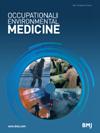英国与镍、铬和钴有关的工作相关呼吸道疾病趋势:1996-2019 年健康与职业研究 (THOR) 网络的描述性发现
IF 3.9
2区 医学
Q1 PUBLIC, ENVIRONMENTAL & OCCUPATIONAL HEALTH
引用次数: 0
摘要
背景 职业接触金属可能会引发呼吸系统疾病,对个人的健康、经济和就业造成不利影响。尽管如此,人们对这些呼吸系统疾病的长期发病率知之甚少。目的 本研究旨在调查英国与镍、铬和钴有关的工作相关呼吸道疾病的发病趋势。方法 提取 1996 年至 2019 年(包括 2019 年)期间向英国工作相关和职业呼吸道疾病监测计划(SWORD)报告的由镍、铬或钴引起的职业呼吸道疾病病例,并将其分为 6 个 4 年时间段。病例以致病金属接触、职业和工业部门为特征。利用国家统计局的就业数据计算疾病发病率(根据医生参与率和回复率进行调整)。结果 在研究期间向 SWORD 报告的病例中,1%(173 例实际病例)的呼吸系统问题归因于镍、铬或钴。哮喘诊断占最大比例(74.4%),其次是肺癌(8.9%)和尘肺(6.7%)。病例的平均年龄为 47 岁(SD 13);93% 为男性。年发病率从最初 4 年的每百万就业人口 1.6 例下降到最近的 0.2 例。结论 24 年来,英国金属相关职业呼吸道疾病的发病率有所下降。这可能是由于工作条件的改善导致接触金属的机会减少,但也可能是由于可能产生病例的行业关闭所致。如有合理要求,可提供相关数据。本文章由计算机程序翻译,如有差异,请以英文原文为准。
Trends in work-related respiratory diseases attributed to nickel, chromium and cobalt in the UK: descriptive findings from The Health and Occupation Research (THOR) network 1996–2019
Background Occupational exposure to metals can be associated with respiratory diseases which can adversely affect the individual’s health, finances and employment. Despite this, little is known about the incidence of these respiratory conditions over prolonged periods of time. Aims This study aimed to investigate the trends in the incidence of work-related respiratory diseases attributed to nickel, chromium and cobalt in the UK. Methods Cases of occupational respiratory diseases caused by nickel, chromium or cobalt reported to Surveillance of Work-related and Occupational Respiratory Disease (SWORD), the UK-based surveillance scheme between 1996 and 2019 (inclusive), were extracted and grouped into six 4-year time periods. Cases were characterised by causative metal exposure, occupational and industrial sector. Incidence rates diseases (adjusted for physician participation and response rate) were calculated using ONS employment data. Results Of cases reported to SWORD during the study period, 1% (173 actual cases) of respiratory problems were attributed to nickel, chromium or cobalt. Diagnoses of asthma compromised the largest proportion of diagnoses (74.4%), followed by lung cancer (8.9%) and pneumoconiosis (6.7%). Cases had a mean age of 47 years (SD 13); 93% were men. The annual incidence fell from 1.6 per million employed in the first 4-year period, to 0.2 in the most recent period. Conclusions Over 24 years, a decline in the incidence of metal-related occupational respiratory diseases was observed in the UK. This could be attributed to improvements in working conditions which resulted in reduced metal exposure but could also be due to closure of industries that might have generated case returns. Data are available upon reasonable request.
求助全文
通过发布文献求助,成功后即可免费获取论文全文。
去求助
来源期刊

Occupational and Environmental Medicine
医学-公共卫生、环境卫生与职业卫生
CiteScore
8.30
自引率
2.00%
发文量
98
审稿时长
2 months
期刊介绍:
Occupational and Environmental Medicine is an international peer reviewed journal covering current developments in occupational and environmental health worldwide. Occupational and Environmental Medicine publishes high-quality research relating to the full range of chemical, physical, ergonomic, biological and psychosocial hazards in the workplace and to environmental contaminants and their health effects. The journal welcomes research aimed at improving the evidence-based practice of occupational and environmental research; including the development and application of novel biological and statistical techniques in addition to evaluation of interventions in controlling occupational and environmental risks.
 求助内容:
求助内容: 应助结果提醒方式:
应助结果提醒方式:


